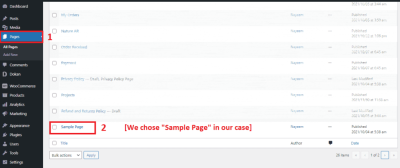If you’re a WordPress user or website owner, you’ve probably come across the term “CIN” and wondered what it really means for your site. In today’s digital landscape, understanding how your website communicates with search engines and other platforms is crucial. That’s where WordPress CIN comes into play. It’s a powerful feature that can help improve your site’s visibility and ensure that your content reaches the right audience. In this post, we’ll break down what
What Is WordPress CIN and How Does It Work

WordPress CIN stands for Content Identification Number. Think of it as a unique ID assigned to your website’s content, helping search engines and other services identify and manage your site more effectively. Essentially, CIN acts like a digital fingerprint for your content, making it easier for platforms to recognize, index, and serve your pages accurately.
So, how does it work? When you publish or update content on your WordPress site, the CIN system generates a unique identifier for that specific piece of content. This identifier is then communicated to search engines through various signals, such as sitemaps or metadata tags. This process ensures that search engines know exactly which content is new or updated, reducing confusion and improving the accuracy of search results.
Here’s a quick overview of the process:
- Content Creation or Update: You add new blog posts, pages, or update existing content on your website.
- CIN Generation: WordPress assigns a unique CIN to this content automatically.
- Communication with Search Engines: The CIN information is included in sitemaps or meta tags sent to search engines like Google or Bing.
- Indexing and Recognition: Search engines use the CIN to identify your content precisely, helping them decide whether to re-index or update their records.
This system helps prevent duplicate content issues, ensures your latest updates are recognized quickly, and improves your site’s overall SEO health. Plus, it provides a more structured way to manage your content’s visibility across different platforms.
In a nutshell, WordPress CIN acts as a bridge between your website and search engines, making sure everyone is on the same page when it comes to your content. Understanding and leveraging this feature can give your website a competitive edge and make your content more discoverable than ever before.
The Importance of WordPress CIN for Website Security and Performance

When it comes to managing your WordPress website, understanding the role of WordPress CIN (Content Identification Number) is more than just technical jargon—it’s a key piece in keeping your site secure and running smoothly. Think of CIN as a unique fingerprint for your website’s content, helping to track and verify data across various platforms and services.
Security is a top concern for any website owner. With cyber threats becoming more sophisticated, ensuring your site’s content is authentic and hasn’t been tampered with is crucial. WordPress CIN acts as a safeguard by providing a unique identifier for your content, making it easier to detect unauthorized changes or malicious injections. This way, you can quickly identify if someone has tried to alter your site’s content or inject harmful code.
On the performance side, CIN also plays a significant role. It helps streamline content management, especially when your website relies on multiple integrations, such as third-party plugins or external services. By having a consistent way to verify content, CIN reduces conflicts and errors, resulting in a smoother user experience and faster load times.
Here’s why CIN matters so much:
- Content authenticity: Ensures the content displayed is exactly what you published.
- Enhanced security: Detects unauthorized modifications or potential security breaches.
- Efficient content management: Simplifies synchronization across services and plugins.
- Better performance: Reduces errors, prevents content duplication, and speeds up load times.
In a nutshell, neglecting the importance of WordPress CIN can leave your site vulnerable to security issues and performance hiccups. Embracing its role helps you maintain a trustworthy and speedy website—something your visitors will appreciate and search engines will favor.
How to Check if Your Website Uses WordPress CIN

Wondering whether your WordPress site is utilizing CIN? It’s easier than you might think! Here are some simple ways to check:
- Inspect the source code: Right-click on your webpage and select “View Page Source” or press Ctrl+U (Cmd+U on Mac). Once the source code opens, look for references to CIN or similar identifiers. These might be embedded within meta tags, scripts, or comments.
- Use browser developer tools: Open Chrome DevTools (F12 or right-click and choose “Inspect”) and go to the “Elements” tab. Use the search feature (Ctrl+F or Cmd+F) to find keywords like “CIN” or “content id.”
- Check your plugins or dashboard: If you’re using a plugin that manages or tracks content identifiers, navigate to its settings within your WordPress admin dashboard. Many plugins display CIN information directly in their interface.
- Use online tools or plugins: There are specialized tools and plugins designed to reveal technical details about your site. Plugins like “Query Monitor” or “WP Debugging” can help you uncover whether CIN is in use.
Additionally, if you’re unsure or prefer a more technical approach, consulting with your developer or hosting provider can give you definitive answers. They can check server logs or database entries related to CIN.
Remember, knowing whether your site employs CIN isn’t just about satisfying curiosity—it’s about understanding your security and content management setup. If your site doesn’t currently use CIN but you see the benefits, consider discussing with your developer about implementing it to boost your website’s integrity and performance.
5. Steps to Implement WordPress CIN on Your Website
So, you’re ready to get started with WordPress CIN (Content Identification Number)? Great! Implementing CIN isn’t complicated, but it does require some careful steps to ensure everything runs smoothly. Think of it as giving your website a unique fingerprint that helps with content management and security. Let’s walk through the process together.
Step 1: Backup Your Website
Before making any significant changes, it’s always a good idea to back up your website. Use a reliable backup plugin like UpdraftPlus or BackupBuddy. This way, if anything goes awry, you can restore your site to its previous state without stress.
Step 2: Install a CIN Plugin or Module
Next, you’ll want to install a plugin that supports CIN functionality. Some popular options include WP Content ID or other plugins designed to handle content identification. You can find these plugins in the WordPress Plugin Repository or via third-party providers. Just head to your dashboard, navigate to Plugins > Add New, search for your preferred CIN plugin, and click Install & Activate.
Step 3: Configure CIN Settings
Once activated, go to the plugin’s settings page. Here, you’ll typically set parameters like how content IDs are generated, whether to auto-assign CINs to new posts, and integration options with other tools or services. Make sure to review these settings carefully and customize them to fit your website’s needs.
Step 4: Generate CINs for Existing Content
If you have existing content, you’ll want to assign CINs to those posts and pages. Most plugins offer an option to bulk generate or assign CINs. This step is crucial for maintaining consistency and ensuring your entire site benefits from content identification.
Step 5: Test the Implementation
Before going live, test the CIN setup thoroughly. Check a few posts or pages to see if CINs are correctly assigned and visible where needed. Also, verify how CINs interact with your theme and other plugins to prevent conflicts.
Step 6: Monitor and Maintain
After implementation, keep an eye on your website’s performance and content management workflows. Regularly update the CIN plugin, and re-generate CINs if you add or modify content extensively. This ongoing maintenance ensures your content identification system stays accurate and effective.
And that’s it! With these steps, you’re well on your way to leveraging WordPress CIN to improve your website’s content management, security, and overall organization. It might seem technical at first, but once set up, it becomes a powerful tool in your website toolkit.
6. Common Issues Related to WordPress CIN and How to Troubleshoot Them
As with any new feature or plugin, implementing WordPress CIN can sometimes come with challenges. Don’t worry—most issues are fixable, and understanding common problems will help you troubleshoot quickly and keep your site running smoothly. Let’s explore some typical issues and how to resolve them.
Issue 1: CIN Not Displaying Correctly
Symptoms: You’ve assigned CINs, but they aren’t visible on your posts or pages, or they appear incorrectly.
- Solution: First, check your plugin settings to ensure CIN display options are enabled. Sometimes, you need to add a shortcode or modify your theme files to show CINs explicitly.
- Verify if your theme supports custom fields or if you need to insert a template tag provided by the plugin.
- If you’re using a caching plugin, clear the cache to see recent changes.
Issue 2: Conflicts with Other Plugins or Themes
Symptoms: The CIN feature causes conflicts, broken layouts, or errors on your site.
- Solution: Deactivate other plugins one by one to identify conflicts. Also, switch to a default WordPress theme like Twenty Twenty-Three to see if the issue persists.
- If a conflict is found, contact the plugin developers or consider replacing the conflicting plugin/theme.
Issue 3: CIN Generation Fails for Existing Content
Symptoms: When trying to bulk assign CINs, the process stalls or doesn’t complete.
- Solution: Increase your server’s PHP memory limit and execution time via your hosting control panel or wp-config.php file.
- Ensure your plugin is updated to the latest version, as updates often fix bugs and improve compatibility.
- If problems persist, contact your hosting provider or plugin support for assistance.
Issue 4: Performance Issues After CIN Implementation
Symptoms: Your website loads slowly or becomes unresponsive after enabling CIN features.
- Solution: Check server resources and optimize your database. Disable any unnecessary plugins that may be adding overhead.
- Use a caching plugin and consider implementing a Content Delivery Network (CDN) to improve load times.
- Review plugin documentation for performance tips specific to CIN.
Final Tips for Troubleshooting
Always keep your plugins, themes, and WordPress core updated to minimize bugs. Regular backups are essential before making significant changes. When in doubt, consult the plugin’s support forum or documentation—they often have solutions for common problems. Remember, troubleshooting is part of the process, and with patience, you’ll ensure your WordPress CIN setup works flawlessly.
7. Best Practices for Maintaining WordPress CIN Effectiveness
Now that you understand what WordPress CIN (Content Identification Number) is and how it helps keep your website organized and secure, it’s important to know how to maintain its effectiveness over time. Think of CIN as the backbone of your content management system—like a reliable GPS that keeps your website on track. To ensure it continues to serve you well, here are some best practices to follow:
Regularly Update Your WordPress and Plugins
Keeping your WordPress core, themes, and plugins up to date is essential. Developers often release updates that patch security vulnerabilities and improve performance. Outdated software can cause CIN-related issues or even make your site vulnerable to attacks. Make it a habit to check for updates at least once a week and install them promptly.
Implement Consistent Content Naming Conventions
Establish clear and consistent naming conventions for your content, including pages, posts, media, and custom post types. This helps prevent duplicate CINs or confusion down the line. For example, use a standard format like category-date-title for filenames or titles, so your system can easily recognize and categorize content.
Monitor Your CIN Data Regularly
Use tools or plugins that allow you to view and analyze your CIN data. Regular monitoring helps you identify irregularities, such as duplicate CINs or incorrect mappings, so you can address issues early. Set a monthly review schedule to keep everything in check.
Backup Your Website Frequently
Backups are a lifesaver. Should anything go wrong—like a plugin conflict or a security breach—you can restore your site to a previous state. Make sure your backups include your CIN data and are stored securely, ideally off-site or in cloud storage.
Limit User Access and Permissions
Only grant CIN-related editing permissions to trusted team members. Limiting access reduces the risk of accidental changes or malicious activities that could disrupt your CIN structure. Use role management plugins to fine-tune permissions.
Document Your CIN Strategy
Keep a clear record of how your CIN system is set up, including naming conventions, workflows, and any customizations. Documentation makes onboarding new team members easier and helps maintain consistency as your website evolves.
Stay Informed About WordPress and CIN Developments
The WordPress ecosystem is always changing. Follow relevant blogs, forums, and official documentation to stay updated on best practices, security alerts, and new features related to CIN and content management.
By following these best practices, you’ll ensure that your WordPress CIN remains a powerful tool in your website’s health and organization. It’s all about proactive management, staying informed, and making sure your content remains secure and easy to navigate.
8. Conclusion and Key Takeaways on WordPress CIN and Website Optimization
Wrapping things up, understanding and effectively managing your WordPress Content Identification Number (CIN) can significantly boost your website’s organization, security, and overall performance. Think of CIN as the unique fingerprint for every piece of content on your site—helping you track, manage, and protect your valuable information with ease.
Here are some key takeaways to keep in mind:
- Purpose of CIN: It uniquely identifies each content item, aiding in organization and security.
- Impact on Performance: Proper CIN management can streamline workflows, reduce errors, and improve site speed.
- Security Benefits: CIN can help detect suspicious activities or unauthorized content modifications.
- Best Practices: Regular updates, consistent naming conventions, backups, monitoring, and documentation all play vital roles in maintaining CIN effectiveness.
- Ongoing Learning: Staying informed about WordPress updates and CIN advancements ensures your strategies remain current.
In the grand scheme of website optimization, CIN may seem like a small component, but its impact is profound. When managed well, it helps create a smoother user experience, simplifies content management, and fortifies your site’s security. Remember, the key to success lies in consistent maintenance and staying proactive about new developments.
So, whether you’re a seasoned developer or a website owner just getting started, taking the time to understand and optimize your WordPress CIN will pay off in the long run. Your website’s health, security, and efficiency depend on it!


